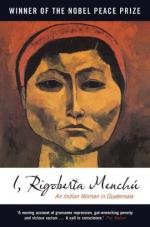|
This section contains 6,382 words (approx. 22 pages at 300 words per page) |

|
SOURCE: Brittin, Alice. “Close Encounters of the Third World Kind: Rigoberta Menchú and Elisabeth Burgos's Me llamo Rigoberta Menchú.” Latin American Perspectives 22, no. 4 (fall 1995): 100–114.
In the following review, Brittin examines the dynamic that Me llamo Rigoberta Menchú—which is considered to be a Central American testimonio—creates between the subject and reader.
Me llamo Rigoberta Menchú: Y así me nació la conciencia is generally regarded as a paradigmatic example of Central American testimonio. In this first-person narrative of novel length, Rigoberta Menchú, a semiliterate Maya Quiché from the Guatemalan highlands, tells her life story to Elisabeth Burgos, a professionally trained ethnographer who, rendering Rigoberta's oral history in written form, acts as both mediator to the reading public and conduit to the publishing industry. Though the significant cultural differences between the two women in ethnic origin, native tongue, nationality, and socioeconomic status suggest that Rigoberta's voice was subject to...
|
This section contains 6,382 words (approx. 22 pages at 300 words per page) |

|


